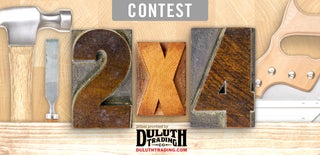Introduction: Baby Changing Table From Five 2x4x8' Studs
Using five 2x4x8' studs I was able to create this changing table for just $11.55 in lumber. The overall dimensions of this changing table are 33 1/2" Wide x 17 1/4" Deep x 33 1/2" High. The changing pad frame(and changing pad) is removable and adds an additional 3 inches in height. The changing pad frame is removable so this can be used as a storage unit after the baby has grown up. This was designed to hold a changing pad we already owned that measured 16" x 32".
Step 1: Gather Materials/Tools
To complete this ible you will need:
Standard Drill with drill/driver bits
Table Saw
Pocket Hole Jig
Chop Saw (optional)
Stapler/Nailer with 7/8" staples/nails
Sander
24 Construction screws 2"
44 Pocket hole Screws 1 1/4" coarse thread
Zip Ties
Wood Glue
Clamps
Step 2: Cut Working Lengths From the Studs
Cut the lengths below using a chop saw
4 @ 33 1/2"
3 @ 13"
3 @ 29"
9 @ 15 7/8"
1 @ 32"
1 @ 15 3/4"
Step 3: Remove the Rounded Corners
Remove the rounded corners from the lengths listed below.
4 @ 33 1/2"
3 @ 13"
3 @ 29"
1 @ 15 3/4"
9 @ 15 7/8" (set this aside after removing the rounded edges and do not cut in the next step)
To do this:
- First set your table saw blade slightly higher than 1 1/2 inches.
- Set your fence to 3 1/4 inches and rip 1/4" off one side of each length listed above.
- Set your fence to 3 inches and rip 1/4" off the opposite side of each length listed above.
You should now have stock that is 1 1/2" x 3" for each length listed above.
Step 4: Create 5/8" Stock
Using the 1 1/2" x 3" stock listed below, Create 5/8" x 3" stock out of each length.
4 @ 33 1/2"
3 @ 13"
3 @ 29"
1 @ 15 3/4"
-Set your table saw blade to slightly higher than 3" cutting height
-Set your rip fence so that the center of your 1 1/2" width is centered on center line of your saw blade.
-Make your cuts slowly.
-The stock listed above will become the stock listed below
8 @ 5/8" x 3" x 33 1/2"
6 @ 5/8" x 3" x 13"
6 @ 5/8" x 3" x 29"
2 @ 5/8" x 3" x 15 3/4"
Step 5: Create 3/8" X 3" Shelf Slats
Using the nine 1 1/2" x 3" x 15 7/8" boards set aside in step 2 create slats that are 3/8" thick x 3" wide x 15 7/8" long.
- Adjust your table saw blade to slightly higher than 3" cutting height.
- Set your rip fence to 3/8"
- Cut three thin rips from each board for a total of 27 3/8" x 3" x 15 7/8" slats.
A great tool from making these thin rips can be found in my other instructable Thin-Rip-Push-Block
Step 6: Create 5/8" X 1 3/8" X 33 1/2 Boards
Using two 3" x 5/8" x 33 1/2" boards from step 4, cut four 5/8" x 1 3/8" x 33 1/2" boards.
- Set your blade height to approximately 3/4".
- Set your rip fence to 1 3/8"
- Cut each 3" board into two 1 3/8" boards. This yields 4 boards 5/8" x 1 3/8" x 33 1/2"
Step 7: Create 2 1/4" X 5/8 Material
-Locate the stock below from step 4:
4 @ 5/8" x 3" x 33 1/2"
6 @ 5/8" x 3" x 13"
6 @ 5/8" x 3" x 29"
- Rip all 16 boards listed above to 2 1/4" width.
- Discard the extra material from each rip.
This yields the materials below.
4 @ 5/8" x 2 1/4" x 33 1/2"
6 @ 5/8" x 2 1/4" x 13"
6 @ 5/8" x 2 1/4" x 29"
Step 8: Rip Six 3/8" X 1 1/2" X 32" Shelf Supports
Rip Six 3/8" x 1 1/2" x 32" shelf supports from the remaining 32" 2x4 from step 2.
- First remove 1/4" from one edge of the 2x4 to remove the rounded corners.
- Next set your rip fence to 3/8" and rip six strips to be used as shelf supports.
Step 9: Sand
It's time to sand all of those beautiful cuts we made and clean up the pile of scrap. 50 percent of the time I spent on this project was spent sanding. This also happens to be my least favorite part of any project.
Step 10: Assemble the Side Panels
- Locate 4 side legs 5/8" x 1 3/8" x 33 1/2"
- Mark the location of the side braces by measuring down from the top of the leg and making marks at 13 1/2", 15 3/4", 27", 29 1/4". Repeat for all 4 legs.
- Locate 6 side braces 5/8" x 2 1/4" x 13"
- Attach the side braces to the legs by drilling through the edge of the legs and countersinking the heads. These screws will be completely hidden by the front and rear panels later.
Step 11: Assemble the Front and Back Panels
- Locate the 4 front/back legs 5/8" x 2 1/4" x 33 1/2"
- Mark the location of the front/back braces by measuring down from the top of the leg and making marks at 13 1/2", 15 3/4", 27", 29 1/4". Repeat for all 4 legs.
- Locate the 6 front/back braces 5/8" x 2 1/4" x 29"
- Assemble the front and back braces by attaching to the front/back legs using 1 1/4" coarse thread pocket screws
Step 12: Connect the Panels
Join the panels from the previous two steps using 1 1/4" coarse thread pocket screws. If you are working in unheated garage and it is 5 degrees outside forgo the wood glue. :) I used three pocket screws in each corner for a total of 12.
Step 13: Attach Shelf Supports
Attach the six shelf supports(3/8" x 1 1/2" x 32") using a shelf slat as a guide so that the slats will sit flush with the top of each front/back brace.
Step 14: Install the Shelf Slats
Staple or Nail the twenty seven shelf slats (3/8" x 3" x 15 7/8") onto the shelf supports using a scrap piece of wood as a 1/2" spacer between the slats.
Step 15: Build the Changing Pad Frame
Using two 5/8 x 3 x 15 3/4" and two 5/8 x 3 x 33 1/2" construct the changing pad frame.
- Drill two pocket holes in each end of the two 15 3/4" boards, for a total of 8 pocket holes.
- Square up all four boards and clamp them together.
- Drive in your 1 1/4" Coarse thread pocket screws.
- Use sand paper to round over the inner edges of the frame where your baby may contact.
Step 16: Attach the Changing Pad Frame
Use zip ties to secure the changing pad frame to the top shelf. Attach using screws or doweling if you want a more permanent installation.
Step 17: Musings
Looking back I would probably make the shelf support boards thicker than 3/8". I would probably go with either 5/8" or 3/4". They perform fine at 3/8" but stapling the shelf slats into place was more time consuming due to the fine tolerance involved.
In case anyone did not notice I call most of the boards 5/8" thick. In reality they aren't exactly, we take a 1 1/2" thick board and cut it exactly in half so they are (1 1/2 - 1/8(kerf of my table saw blade))/2 = 11/16" Thick. The actual thickness of your stock will vary based on the kerf of your table saw blade.

Participated in the
Living Without Closets Contest

Participated in the
2x4 Contest











